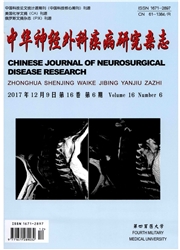

 中文摘要:
中文摘要:
目的评价应用微侵袭手术(显微或神经内镜辅助)经单鼻孔-蝶窦入路切除垂体腺瘤(PAs)的鞍底修复技术与效果。方法对入院的458例PAs患者经单鼻孔-蝶窦入路微侵袭手术切除肿瘤,以不同的手术技术修复鞍底。其中299例(65.3%)为PAs切除后鞍隔膜完好,无脑脊液(CSF)漏,仅有鞍底骨质缺损而行“单纯鞍底修复术”;159例(34.7%)因术中鞍隔膜破裂而有CSF漏液,行“严密鞍底修复术”。结果432例(94.3%)鞍底修复术后疗效良好,未出现CSF漏和其它并发症;26例(5.7%)经蝶术后发生CSF漏,其中18例行早期修补术,8例以腰椎穿刺CSF持续引流而治愈。结论对施行经蝶入路微侵袭手术切除PAs后的鞍底修复很有必要,这是防止CSF漏和垂体脱位的重要方法。
 英文摘要:
英文摘要:
Objective To evaluate the effect of the minimally invasive surgical technique and clinical curative effect on the unilateral endonasal-transspbenoidal approach for removal of pituitary adenomas (PAs) by a microscope or endoscope-assisted technique with sellar floor repair. Methods Four hundred and fifty-eight consecutive patients underwent minimally invasive unilateral endonasal-transsphenoidal surgery. Different techniques of sellar floor repair for each specific condition were used. Two htmdred and ninety-nine (65.3%) patients were considered candidates for "simple sellar repair" after the PAs operation, because there was only a defect of sellar floor bone, the sellar diaphragm was intact and no cerebrospinal fluid (CSF) leakage occurred. While the "tight seUar repair" was performed in 159 cases (34.7%) with CSF leakage caused by intraoperative sella diaphragm rupture. Results Four hundred and thirty-two patients (94. 3% )who underwent the sellar repair did not show postoperative cerebrospinal leak or other complications. A total of 26 cases (5. 7% ) with postoperative CSF leakage were cured by means of early reoperation in 18 cases and lumbar drainage in 8 cases. Conclusion Sellar floor repair is necessary for PAs patients who received operations via transspbenoidal approach. This is an important method to prevent CSF leakage and pituitary dislocation after the PAs removal via transsphenoidal approach.
 同期刊论文项目
同期刊论文项目
 同项目期刊论文
同项目期刊论文
 期刊信息
期刊信息
